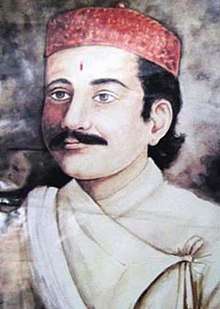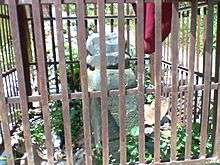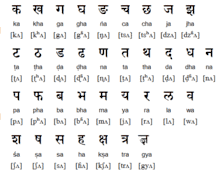Nepali language
Nepali (Devanagari: नेपाली, pronounced [neˈpali]) is an Indo-Aryan language of the sub-branch of Eastern Pahari. It is the official language of Nepal and one of the 22 scheduled languages of India. Also known by the endonym Khas kura[1] (Devanagari: खस कुरा), the language is also called Gorkhali or Parbatiya in some contexts. It is spoken mainly in Nepal and by about a quarter of the population in Bhutan.[5] In India, Nepali has official status in the state of Sikkim and in the Darjeeling Sadar subdivision and Kalimpong district of West Bengal. It has a significant number of speakers in the states of Arunachal Pradesh, Assam, Himachal Pradesh, Manipur, Mizoram and Uttarakhand. It is also spoken in Myanmar and by the Nepali diaspora worldwide.[6] Nepali developed in proximity to a number of Indo-Aryan languages, most notably the other Pahari languages and Maithili and shows Sanskrit influence.[7] However, owing to Nepal's location, it has also been influenced by Tibeto-Burman languages. Nepali is mainly differentiated from Central Pahari, both in grammar and vocabulary, by Tibeto-Burman idioms owing to close contact with this language group.[8]
| Nepali | |
|---|---|
| Gorkhali, Khaskura, Nepalese, Parbate, Eastern Pahadi | |
| नेपाली/खस कुरा | |
 The word "Nepali" written in Devanagari | |
| Pronunciation | [neˈpali] |
| Native to | Nepal |
| Ethnicity | Khas people[1] (historically) |
Native speakers | 16 million (2011 census)[2] 9 million L2 speakers (2011 census)[2] |
Indo-European
| |
| Devanagari Devanagari Braille Takri (historical) | |
Signed forms | Signed Nepali |
| Official status | |
Official language in | |
| Regulated by | Nepal Academy |
| Language codes | |
| ISO 639-1 | ne |
| ISO 639-2 | nep |
| ISO 639-3 | nep – inclusive codeIndividual codes: npi – Nepalidty – Doteli |
| Glottolog | nepa1254[3]nepa1252 duplicate code[4] |
| Linguasphere | 59-AAF-d |
 World map with significant Nepali language speakers Dark Blue: Main official language, Light blue: One of the official languages, Red: Places with significant population or greater than 20% but without official recognition. | |
Historically, the language was called Khas Speech (Khas Kurā), spoken by the Khas people of Karnali Region and Gorkhali (language of the Gorkha Kingdom) before the term Nepali was adopted.[1] The origin of modern Nepali language is believed to be from Sinja valley of Jumla. Therefore, the Nepali dialect “Khas Bhasa” is still spoken among the people of the region.[9]
Literature

Nepali developed a significant literature within a short period of a hundred years in the 19th century. This literary explosion was fueled by Adhyatma Ramayana; Sundarananda Bara (1833); Birsikka, an anonymous collection of folk tales; and a version of the ancient Indian epic Ramayana by Bhanubhakta Acharya (d. 1868). The contribution of trio-laureates Lekhnath Paudyal, Laxmi Prasad Devkota, and Balkrishna Sama took Nepali to the level of other world languages. The contribution of expatriate writers outside Nepal, especially in Darjeeling and Varanasi in India, is also notable.
Number of speakers
According to the 2011 national census, 44.6 percent of the population of Nepal speaks Nepali as the first language.[10] and 32.8 percent speaks Nepali as a second language[11]. The Ethnologue reports 12,300,000 speakers within Nepal (from the 2011 census).[11] As per the 2011 Census of India, there were a total of 2,926,168 native speakers of the language in India, amounting to 0.25% of the total population.
Nepali is traditionally spoken in the hilly regions of Nepal. The language is prominently used in governmental usages in Nepal and is the everyday language of the local population. The exclusive use of Nepali in the court system and by the government of Nepal is being challenged. Gaining recognition for other languages of Nepal was one of the goals of the decade large Maoist insurgency in Nepal.[12]
In Bhutan, native Nepali speakers, known as Lhotshampa, are estimated at about 35 percent [13] of the population. This number includes displaced Bhutanese refugees, with unofficial estimates of the ethnic Bhutanese refugee population as high as 30 to 40 percent, constituting a majority in the south (about 242,000 people).[14]
There are 2.9 million Nepali language speakers in India.[15]
History

The oldest discovered inscription in the Nepali language is believed to be the Dullu Inscription, which is believed to have been written around the reign of King Bhupal Damupal around the year 981 CE. It is believed that the language bore a lot of similarities with other Northwest Indian languages like Punjabi, Sindhi and Lahanda. It's believed that there is some mention of the Khasa language in texts like Manusmriti, Rajatarangini and the Puranas. The Khashas were documented to have ruled over a vast territory comprising what is now western Nepal, parts of Garhwal and Kumaon in northern India, and some parts of southwestern Tibet. King Ashoka Challa (1255–78 CE) is believed to have proclaimed himself Khasha-Rajadhiraja (emperor of the Khashas) in a copper-plate inscription found in Bodh Gaya, and several other copper-plates in the ancient Nepali language have been traced back to the descendants of the King.
The currently popular variant of Nepali is believed to have originated around 500 years ago with the mass migration of a branch of Khas people from the Karnali-Bheri-Seti eastward to settle in lower valleys of the Karnali and the Gandaki basin that were well-suited to rice cultivation. Over the centuries, different dialects of the Nepali language with distinct influences from Sanskrit, Maithili, Hindi and Bengali are believed to have emerged across different regions of the current-day Nepal and Uttarakhand, making Khasa the lingua franca.
However, the institutionalization of the Nepali language is believed to have started with the Shah kings of Gorkha Kingdom, in the modern day Gorkha district of Nepal. In 1559 AD, a prince of Lamjung, Dravya Shah established himself on the throne of Gorkha with the help of local Khas and Magars. He raised an army of khas people under the command of Bhagirath Panta. Later, in the late 18th century, his descendant, Prithvi Narayan Shah, raised and modernised an army of Chhetri, Thakuri, Magars and Gurung people among others and set out to conquer and consolidate dozens of small principalities in the Himalayas. Since Gorkha had replaced the original Khas homeland, Khaskura was redubbed Gorkhali "language of the Gorkhas.
One of the most notable military achievements of Prithvi Narayan Shah was the conquest of Kathmandu Valley. This region was called Nepal at the time. After the overthrowing of the Malla rulers, Kathmandu was established as Prithvi Narayan's new capital.
The Khas people originally referred to their language as Khas kurā ("Khas speech"), which was also known as Parbatiya (or Parbattia or Paharia, meaning language of the hill country).[16][17] The Newar people used the term "Gorkhali" as a name for this language, as they identified it with the Gorkhali conquerors. The Gorkhalis themselves started using this term to refer to their language at a later stage.[18] The census of India prior to independence used the term Naipali at least from 1901 to 1951, the 1961 census replacing it with Nepali.[19][20]

Expansion – particularly to the north, west, and south – brought the growing state into conflict with the British and the Chinese. This led to wars that trimmed back the territory to an area roughly corresponding to Nepal's present borders. After the Gorkha conquests, the Kathmandu valley or Nepal became the new center of politics. As the entire conquered territory of the Gorkhas ultimately became Nepal, in the early decades of the 20th century, Gorkha language activists in India, especially Darjeeling and Varanasi, began petitioning Indian universities to adopt the name 'Nepali' for the language.[21] Also in an attempt to disassociate himself with his Khas background, the Rana monarch Jung Bahadur Rana decreed that the term Gorkhali be used instead of Khas kurā to describe the language. Meanwhile, the British Indian administrators had started using the term "Nepal" to refer to the Gorkha kingdom. In the 1930s, Nepal government also adopted this term fully. Subsequently, the Khas language came to be known as "Nepali language".[1]
Nepali is spoken indigenously over most of Nepal west of the Gandaki River, then progressively less further to the east.[22]
Dialects
Dialects of Nepali include Acchami, Baitadeli, Bajhangi, Bajurali, Bheri, Dadeldhuri, Dailekhi, Darchulali, Darchuli, Doteli, Gandakeli, Humli, Purbeli, and Soradi.[11] Jhapali and Syangjali are closely related languages.[11]
Phonology
Nepali is written in Devanagari script. Primarily a system of transliteration from the Indian scripts, [and] based in turn upon Sanskrit" (cf. IAST), these are the salient features of it: subscript dots for retroflex consonants; macrons for etymologically, contrastively long vowels; h denoting aspirated plosives. Tildes denote nasalized vowels.
Vowels and consonants are outlined in the tables below. Hovering the mouse cursor over them will reveal the appropriate IPA symbol, while in the rest of the article hovering the mouse cursor over underlined forms will reveal the appropriate English translation.
|
| ||||||||||||||||||||||||||||||||||||||||||||||||||||||||||||||||||||||||||||||||||||||||||||||||||||||||||||||||||||||||||||||||||||||||||||||||||||||||||
Vowels
Monophthongs
| Front | Central | Back | |
|---|---|---|---|
| High | i ĩ | u ũ | |
| Close-mid | e ẽ | o | |
| Open-mid | ʌ ʌ̃ | ||
| Open | a ã |
Nepali distinguishes six oral vowels and five nasal vowels. /o/ does not have a phonemic nasal counterpart, although it is often in free variation with [õ].
Diphthongs
Nepali has ten diphthongs: /ui/, /iu/, /ei/, /eu/, /oi/, /ou/, /ʌi/, /ʌu/, /ai/, and /au/.
Consonants
| Bilabial | Dental | Alveolar | Retroflex | Palatal | Velar | Glottal | ||||||||
|---|---|---|---|---|---|---|---|---|---|---|---|---|---|---|
| Nasal | m | n | ɳ | ɲ | ŋ | |||||||||
| Stop | p pʰ |
b bʱ |
t tʰ |
d dʱ |
ts tsʰ |
dz dzʱ |
ʈ ʈʰ |
ɖ ɖʱ |
k kʰ |
ɡ ɡʱ |
||||
| Fricative | s | ʂ | ɕ | ɦ | ||||||||||
| Rhotic | r | |||||||||||||
| Approximant | (w) | l | (j) | |||||||||||
[j] and [w] are nonsyllabic allophones of [i] and [u], respectively. Every consonant except [j], [w], /l/, and /ɦ/ has a geminate counterpart between vowels. /ɳ/ and /ʃ/ also exist in some loanwords such as /baɳ/ बाण "arrow" and /nareʃ/ नरेश "king", but these sounds are sometimes replaced with native Nepali phonemes.
Final schwas may or may not be preserved in speech. The following rules can be followed to figure whether or not Nepali words retain the final schwa. Nepali retains the schwa for the final syllable if:
1) The syllable is a conjunct. अन्त (anta - end), सम्बन्ध (sambandha - relation), श्रेष्ठ (shrestha - greatest/ a last name) Exceptions: conjuncts such as ञ्ज ञ्च in मञ्च(manc - stage) गञ्ज(ganj - city) and occasionally the last name पन्त (panta/ pant)
2) For any verb form the final schwa is always retained unless the schwa cancelling halanta is present. हुन्छ(huncha - it happens), भएर(bhaera - in happening so/ therefore), गएछ(gaecha - he apparently went) but छन्(chan - they are), गइन्(gain - she went)
Meanings may change with the wrong orthography: गइन(gaina)= she didn't go VS गइन् (gain) = she went 3) Adverbs, onomatopoeia and postpositions usually maintain the schwa and if they don't a halanta is acquired: अब (aba - now), तिर (tira - towards), आज (aaja- today) सिम्सिम् (simsim - drizzle) VS झन् (jhan- more)
4) Few exceptional nouns such as: दुख(dukha - suffering), सुख (sukha - pleasure)
Grammar
Nepali is an SOV language. There are three major levels or gradation of honorific- low, medium and high. Low honorific is used where no respect is due, medium honorific is used to signify equal status or neutrality and high honorific signifies respect. There is also a separate highest level honorific, that was used to refer to members of the Royal family, and by the Royals among themselves. It is still in use by elite dynasties like Shahs, Ranas, Pandes, etc. and is increasingly being embraced by the elite class in general.
Writing

Numbers
| Numeral | Written | IAST | IPA | Etymology | |
|---|---|---|---|---|---|
| 0 | ० | शुन्य/सुन्ना | śūnya | /ʃunjʌ/ | Sanskrit śūnya (शून्य) |
| 1 | १ | एक | ek | /ek/ | Sanskrit eka (एक) |
| 2 | २ | दुई | duī | /d̪ui/ | Sanskrit dvi (द्वि) |
| 3 | ३ | तीन | tīn | /t̪in/ | Sanskrit tri (त्रि) |
| 4 | ४ | चार | cār | /t͡sar/ | Sanskrit catúr (चतुर्) |
| 5 | ५ | पाँच | pāṃc | /pãt͡s/ | Sanskrit pañca (पञ्च) |
| 6 | ६ | छ | cha | /t͡sʰʌ/ | Sanskrit ṣáṣ (षष्) |
| 7 | ७ | सात | sat | /sat̪/ | Sanskrit saptá (सप्त) |
| 8 | ८ | आठ | āṭh | /aʈʰ/ | Sanskrit aṣṭá (अष्ट) |
| 9 | ९ | नौ | nau | /nʌu/ | Sanskrit náva (नव) |
| 10 | १० | दश | daś | /d̪ʌs/ | Sanskrit dáśa दश |
| 11 | ११ | एघार | eghār | /eɡʱar/ | |
| 12 | १२ | बाह्र | bāhr | /barʱ/ | |
| 20 | २० | बीस | vis | /bis/ | |
| 21 | २१ | एक्काइस | ekkāis | /ekkais/ | |
| 22 | २२ | बाइस | bāis | /bais/ | |
| 100 | १०० | एक सय | ek say | /ek sʌi/ | |
| 1 000 | १००० | एक हजार | ek hajār | /ek ɦʌd͡zar/ | |
| 10 000 | १०००० | दश हजार | daś hajār | /d̪ʌs ɦʌd͡zar/ | |
| 100 000 | १००००० | एक लाख | ek lākh | /ek lakʰ/ | See lakh |
| 1 000 000 | १०००००० | दश लाख | daś lākh | /d̪ʌs lakʰ/ | |
| 10 000 000 | १००००००० | एक करोड | ek karoḍ | /ek kʌroɽ/ | See crore |
See also
- Languages of Nepal
- Vikram Samvat
- Nepali literature
- Nepali phonology
- Numbers in Nepali language
References
- Richard Burghart 1984, pp. 118-119.
- Nepali at Ethnologue (21st ed., 2018)
Nepali at Ethnologue (21st ed., 2018)
Doteli at Ethnologue (21st ed., 2018) - Hammarström, Harald; Forkel, Robert; Haspelmath, Martin, eds. (2017). "Nepali [1]". Glottolog 3.0. Jena, Germany: Max Planck Institute for the Science of Human History.
- Hammarström, Harald; Forkel, Robert; Haspelmath, Martin, eds. (2017). "Nepali [2]". Glottolog 3.0. Jena, Germany: Max Planck Institute for the Science of Human History.
- Language Gulper: Languages and Ethnic Groups of Bhutan (2014).
- "Official Nepali language in Sikkim & Darjeeling" (PDF). CensusIndia.gov.in.
- Jain, Danesh; Cardona, George (26 July 2007). The Indo-Aryan Languages. ISBN 9781135797119.
- Hodgson, Brian Houghton (2013). Essays on the Languages, Literature, and Religion of Nepál and Tibet (Reprint ed.). Cambridge University Press. p. 2. ISBN 9781108056083. Retrieved 27 March 2014.
- "Brief Introduction". Retrieved 25 February 2018.
- "Major highlights" (PDF). Central Bureau of Statistics. 2013. p. 4. Archived from the original (PDF) on 17 July 2013. Retrieved 12 September 2013.
- "Nepali (npi)". Ethnologue. Retrieved 6 October 2016.
- Gurung, Harka (19–20 January 2005). Social Exclusion and Maoist Insurgency. p. 5. Retrieved 13 April 2012 – via Google Books.
- "Background Note: Bhutan". U.S. Department of State. 2 February 2010. Retrieved 2 October 2010.
- Worden, Robert L.; Savada, Andrea Matles (ed.) (1991). "Chapter 6: Bhutan - Ethnic Groups". Nepal and Bhutan: Country Studies (3rd ed.). Federal Research Division, United States Library of Congress. pp. 424. ISBN 978-0-8444-0777-7. Retrieved 2 October 2010.CS1 maint: extra text: authors list (link)
- "Census of India". Archived from the original on 13 May 2010. Retrieved 7 January 2008.
- Balfour, Edward (1871). Cyclopædia of India and of Eastern and Southern Asia, Commercial, Industrial and Scientific: Products of the Mineral, Vegetable and Animal Kingdoms, Useful Arts and Manufactures. Scottish & Adelphi presses. p. 529 – via Google Books.
- Cust, Robert N. (1878). A Sketch of the Modern Languages of the East Indies. Routledge. p. 51. ISBN 9781136384691 – via Google Books.
- Richard Burghart 1984, p. 118.
- General, India Office of the Registrar (1967). Census of India, 1961: Tripura. Manager of Publications. p. 336 – via Google Books.
Nepali (Naipali in 1951)
- Commissioner, India Census; Gait, Edward Albert (1902). Census of India, 1901. Office of the Superintendent of Government Printing, India. p. 91 – via Internet Archive.
Naipali is an Indo-Aryan language spoken by the upper classes in Nepal, whereas the minor Nepalese languages, such as Gurung, Magar, Jimdar, Yakha, etc., are members of the Tibeto-Burman family
- Onta, Pratyoush (1996) "Creating a Brave Nepali Nation in British India: The Rhetoric of Jati Improvement, Rediscovery of Bhanubhakta and the Writing of Bir History" in Studies in Nepali History and Society 1(1), p. 37-76.
- "Nepal". Ethnologue. Retrieved 29 March 2015.
Bibliography
- Richard Burghart (1984). "The Formation of the Concept of Nation-State in Nepal". The Journal of Asian Studies. 44 (1): 101–125. doi:10.2307/2056748. JSTOR 2056748.CS1 maint: ref=harv (link)
Further reading
- पोखरेल, मा. प्र. (2000), ध्वनिविज्ञान र नेपाली भाषाको ध्वनि परिचय, नेपाल राजकीय प्रज्ञा प्रतिष्ठान, काठमाडौँ।
- Schmidt, R. L. (1993) A Practical Dictionary of Modern Nepali.
- Turner, R. L. (1931) A Comparative and Etymological Dictionary of the Nepali Language.
- Clements, G.N. & Khatiwada, R. (2007). “Phonetic realization of contrastively aspirated affricates in Nepali.” In Proceedings of ICPhS XVI (Saarbrücken, 6–10 August 2007), 629- 632.
- Hutt, M. & Subedi, A. (2003) Teach Yourself Nepali.
- Khatiwada, Rajesh (2009). "Nepali". Journal of the International Phonetic Association. 39 (3): 373–380. doi:10.1017/S0025100309990181.
- Manders, C. J. (2007) नेपाली व्याकरणमा आधार A Foundation in Nepali Grammar.
- Dr. Dashrath Kharel, "Nepali linguistics spoken in Darjeeling-Sikkim"
External links
| Nepali edition of Wikipedia, the free encyclopedia |
| Wikivoyage has a travel guide for Nepali phrasebook. |